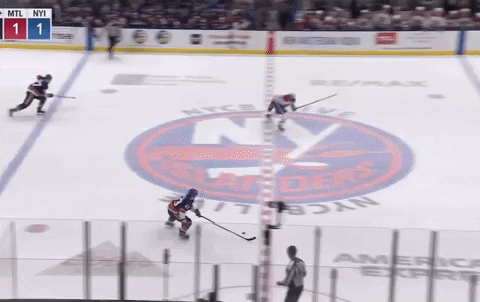
One of the most dangerous plays in hockey is a 2v1 rush chance.
According to Dom Galarmini of Stathletes, the probability of a 2v1 turning into a goal is 22%. These are dangerous situations that need to be converted.
Expected Goals by situation (includes string of rebounds leading to goal)...
Poll A: Breakaway✅ (0.25) vs. 3v1 (0.24) Poll B: three 2v1s (0.66) vs. two 2v0s✅ (0.70)#sundayviz @HockeyAnalytics @MeghanChayka pic.twitter.com/NpVYcuilQJ — Domenic Galamini Jr. (@DomGalamini) November 8, 2020
Let's dive into 2v1 rushes from the offensive perspective to understand how to best maximize the effectiveness for the attacking team.
Puck carrier
On an odd-man rush, the puck carrier is the key decision-maker. They are the ones who choose to pass or shoot. Having their head up and reading the defender is of utmost importance. Ideally, the puck carrier wants to do two things:
1. Work to and stay inside of the dots.
Puck carriers want to remain a dual-threat capable of releasing a shot or pass. If the puck carrier does not remain a shot threat, the goalie and defender can cheat to the pass option. Keeping opponents honest is key. Often in youth hockey, you’ll see players that skate themselves into the corner, killing their shooting angle and limiting their options. Here is an example of Mathew Barzal doing it right. 
2. Slow down
Slowing down allows players to create time to make the best decision as to whether to shoot or pass depending on what the defence offers. Think back to the Mighty Ducks movie when Coach Orian was talking with Charlie Conway when teaching him defence: "Make him make the first move, Conway!" When in a 2v1 situation, whomever makes the first move usually loses, as they tipped their hand. Slowing up, staying a duel-threat challenges the defender to make the first move and for the puck carrier to make the best play possible. This isn't a trivial matter... here is a great example of Patrick Kane working on slowing up on the rush while in a duel-threat position.
Passing option
Non-puck carriers must prepare themselves in a ready position to catch a pass or one-time a shot on goal. This requires an open body position -- front foot toe cap toward the end boards and loose back knee/skate. Thus, allowing for the largest possible range for a player to get them a useful puck (also known as a player's "wheelhouse"). Sometimes players will even skate backward before opening their front skate. Sometimes players glide on the front foot awaiting the pass. Both work and create larger than normal wheelhouses for a one-time shot. https://twitter.com/CoachRevak/status/1227236661962166274?s=20
Clip of the day - Shooting, Open up for 1-timer
— Greg Revak, CFP® (@CoachRevak) February 11, 2020
When on the rush it’s advantageous to open up your body to prepare for a pass
Keys 🔑
- Open up hips - For power and large sweet spot
- Soft strong side knee to drop body weight down into the stick
- Stick in a ready position pic.twitter.com/sfHhx3HBSK
Deception
Alright, we have the basics down... now we move onto the macro-level tactics. In a straight forward situation with only option A + option B, the defender can have an affect over what the offence truly wants to do. Just like in magic and in poker, we want players to add wrinkles into the situation. “Looking off” what they really want to do is a great start. Examples of faking a pass before shooting:
Clip of the day - Rush, fake pass & shoot
— Greg Revak, CFP® (@CoachRevak) January 17, 2020
Deception & misinformation creates improved chances
By looking + giving information that looks like a pass before shooting, the puck carrier controls their opponents
Players move to a better angle before releasing their shot pic.twitter.com/EWXe1pxulD
Examples of faking a shot before passing:
Clip of the day - Deceptively passing
— Greg Revak, CFP® (@CoachRevak) October 4, 2019
Locking the goalie into respecting the shot then dishing to a teammate.
These players do a great job looking like they will shoot then rolling wrists and/or contorting their bodies to move pucks to high percentage shots and tap-ins. pic.twitter.com/XMudWW1M3t
Early pass
A recent trend that we heartily endorse is passing before the top of the circles. The goal is to disrupt how a defender plays the rush. Often, this leads the defender into an earlier and more difficult decision, thus creating more space and options for the attacking team. As an added bonus (particularly at the lower levels) goalies that have to adjust their angle multiple times on the same rush are less apt to be square to the eventual shot.
Clip of the day - Odd man rush, Passing early
— Greg Revak, CFP® (@CoachRevak) November 8, 2019
Passing before the top of the circles disrupts the defender’s read + play
They are setting up to play a rush and have to switch their looks due to early pass. Same with goalies
Watch the D as they get caught in no mans land pic.twitter.com/GE9ywO8SkB
Summary
- Read the defence
- Stay a duel-threat
- Open & ready body positioning
- Add deception + pass early















